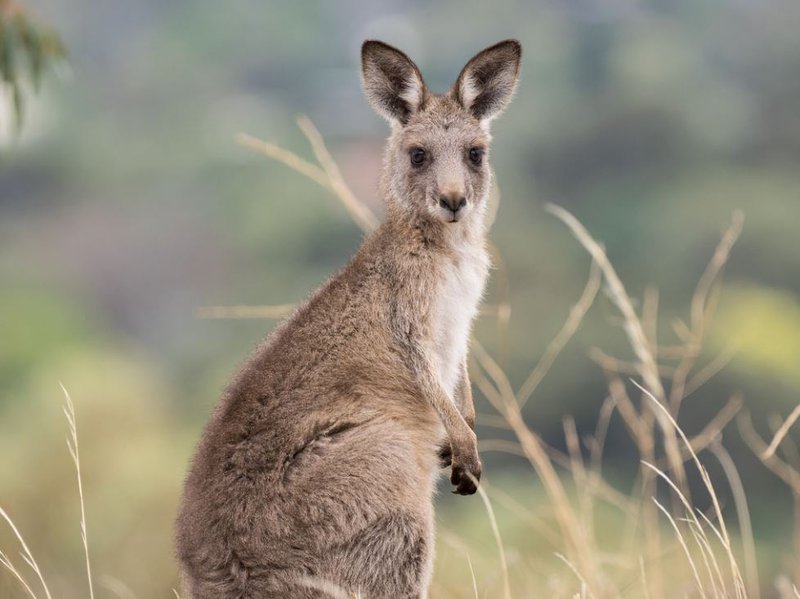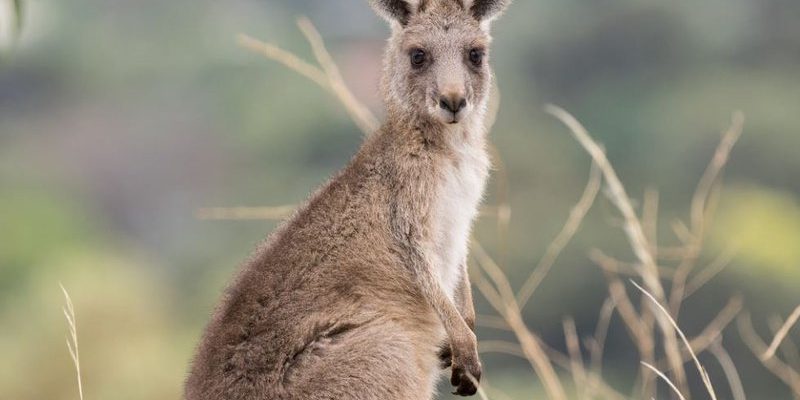
Eastern Grey Kangaroos are herbivores, primarily munching on grasses and leaves. Their eating habits might not seem wild compared to predators, but there’s a lot of strategy here! They’ve adapted to graze on the nutrient-rich pastures of Australia, but that’s just one part of their survival story. So, get comfy as we hop into the details of their diet and hunting strategies.
Understanding the Eastern Grey Kangaroo’s Diet
Eastern Grey Kangaroos are primarily herbivores, which means their diet consists mainly of plants. You might be surprised to learn that these kangaroos primarily graze on *grasses*, *leaves*, and occasionally *fruits* or *flowers*. Their ability to digest tough plant material is due to their specialized stomachs, which function similarly to a cow’s. This means they can break down fibrous greenery effectively, extracting the nutrients they need.
Additionally, they have a knack for foraging. Eastern Greys often shift their eating habits based on the season. In spring and summer, when the grass is lush and abundant, they feast on fresh growth. Come autumn and winter, when vegetation is sparse, they will turn to tougher, more fibrous grasses. This flexibility in their diet is a key survival trait, enabling them to adapt to the changing availability of food in their native environments.
Another interesting aspect of their diet is how they obtain water. While kangaroos can survive on the moisture from the grasses they eat, they will also drink from available water sources. This is crucial in Australia’s often dry climate. They tend to feed during the cooler parts of the day, dawn and dusk, to avoid the heat, which helps in maintaining hydration levels.
Foraging Behavior of Eastern Grey Kangaroos
You might be wondering how these kangaroos actually find their food in the wild. Their foraging behavior is quite fascinating. Eastern Grey Kangaroos are social animals and often graze in groups called mobs. This behavior not only allows them to cover more ground while searching for food but also provides safety in numbers. When one kangaroo is on alert, others can continue to munch peacefully.
While foraging, they use their keen sense of sight and sound to detect potential predators. They’ll often take a few hops forward, nibble at the grass, and then stop to scan their surroundings. If they sense danger—like a hungry dingo or a stalking eagle—they’ll bounce away quickly, showcasing how their diet and hunting strategies are interconnected.
Their method of grazing can also be quite efficient. They tend to eat in a way that leaves the grass relatively untouched, allowing it to regrow quickly. This sustainable approach ensures that they will have food available in the future, which is essential for their long-term survival.
The Role of Competition in Their Diet
In the wild, competition for food can be fierce, especially in areas where resources are limited. Eastern Grey Kangaroos often share their habitats with other herbivorous animals, such as wallabies and sheep. This competition can impact their feeding behavior. To cope with this, they have developed specific foraging strategies to minimize conflict.
For example, they may feed during different times than their grazing neighbors—like early morning or late afternoon—when fewer animals are out and about. They also have a hierarchical social structure within their mobs, which can dictate feeding order. Larger or dominant kangaroos often get first pick of the best patches of grass. This social behavior not only helps them secure food but also maintains harmony within the group.
Another interesting tactic is their ability to remember the locations of food sources. Eastern Grey Kangaroos have good spatial memory, allowing them to return to areas that previously offered abundant feeding opportunities. It’s a bit like having a map in their minds of where the best spots for munching are!
Adaptations for Grazing
Adaptations are critical for survival, and the Eastern Grey Kangaroo has several physical traits that enhance its foraging success. Their unique teeth are vital for their diet. They have strong, flat molars designed for grinding tough plants, and their incisors snip off grass with ease. This combination allows them to efficiently process their plant-based diet.
Moreover, their digestive system is uniquely adapted to extract maximum nutrients from the fibrous plant material they consume. Their stomachs contain specialized bacteria that break down cellulose, the main component of plant cell walls. This relationship helps them gain energy and vital nutrients, even from the toughest of grasses.
Even their social behavior contributes to their grazing success. By foraging in groups, they can cover larger areas more efficiently. You might say they’re a team working toward the same tasty goal, which ultimately benefits their survival.
How Eastern Grey Kangaroos Hunt for Food
Now, while kangaroos aren’t hunters in the traditional sense, their foraging techniques can resemble a form of hunting. They actively search for the best sources of food, making strategic movements that mimic hunting behavior. In a way, they “hunt” by seeking out fresh patches of grass and leafy greens.
Their “hunting” strategy involves more than just looking for food. When they discover a good grazing spot, they’ll quickly move in, often leading other members of their mob to the feast. This not only ensures that the group shares in the bounty but also showcases their social interaction and communication skills.
Interestingly, Eastern Grey Kangaroos can also be opportunistic feeders. If they notice a particularly tasty food source or if a mob member finds a new patch of greenery, they tend to follow suit. This adaptability in their foraging approach might seem simple, but it’s quite ingenious when it comes to survival.
The Impact of Seasonal Changes on Their Diet
As with many animals, seasonal changes can significantly affect the diet of Eastern Grey Kangaroos. During the wetter months, there’s usually an abundance of fresh grass and vegetation. This makes it a prime time for these kangaroos. They will often bulk up during these months, storing energy for the drier periods when food becomes scarce.
In contrast, during droughts or dry seasons, they must be more strategic. They’ll graze on tougher plants and may even shift their grazing areas in search of greener pastures. This constant reassessment of their environment is crucial. It ensures they can adapt their diet and survive despite harsh conditions.
You might also notice that during these changeable times, their social behavior shifts. They may come together in larger mobs to improve their foraging efficacy. By working together, they can cover more ground and increase their chances of finding enough food to sustain all members.
In summary, the diet and foraging strategies of the Eastern Grey Kangaroo are a brilliant combination of adaptation, social behavior, and environmental awareness. Their ability to thrive on a herbivorous diet while effectively navigating the challenges of their habitat makes them stand out in the animal kingdom. Think of them as master foragers, continually adapting to survive in an ever-changing landscape.
Understanding how these kangaroos feed and interact highlights the delicate balance of nature. It’s a reminder of how every creature plays a part in its ecosystem, and how resilience and adaptability are key to survival. So, the next time you see an Eastern Grey Kangaroo hopping through the Australian bush, remember the incredible strategies they employ to maintain their diet and thrive in the wild.

